The trip began with a bust; a crunch, rather. I’d slung a nifty laundry tube from Radius Outfitters over the headrest of the driver’s seat in my Ram Promaster, wedging it carefully between that and the kitchen wall behind me. But when I hopped in the van for the first leg of an autumn journey from Portland, Oregon, to Moab, Utah, the seat was pitched too far forward. No problem. I’ll just push back a little.
Crunch. The rigid mouth of the chute caved in the bottom of the van’s kitchen wall, ripping it clear from the screws that once held it in place. I wasn’t 30 seconds into a two-week road trip, and I’d already busted my chariot.
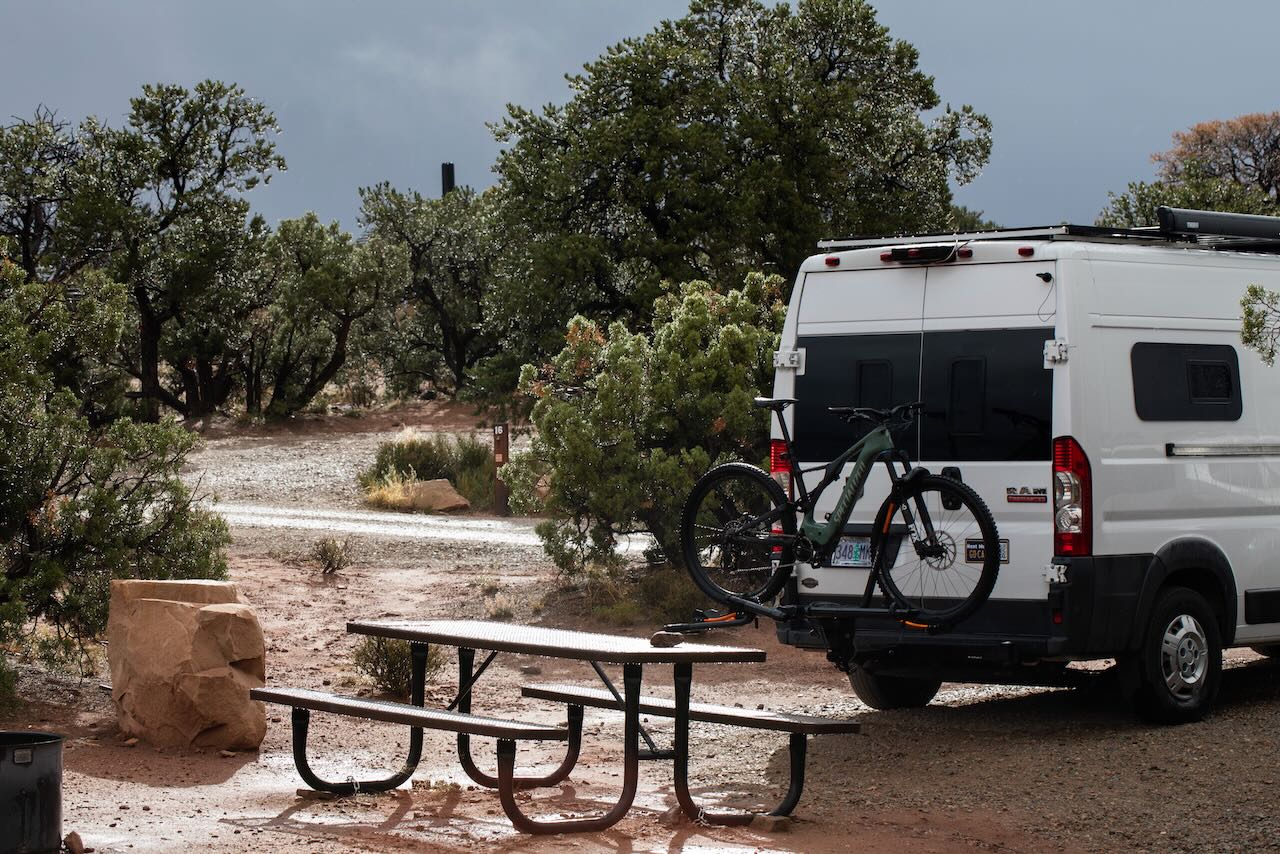
The RAM Promaster camper at rest.
Mopey, I lumbered to Bend, trying not to think about what a fix might look like. Would the cabinets above the sink collapse at the first big bump? Would I have to tear it all out and start over? As the suburbs of Oregon’s largest city faded into the Columbia River Gorge and Highway 26 snaked its way towards the state’s highest mountain, I relaxed a little. Exposed screws or not, it was nice to be on the road.
In Bend, I found a haggard Kurt, my travel companion, weary from weeks of stressful days leading a team of software engineers for one of the country’s biggest network equipment makers. He needed this trip more than I did, and was still in the thick of it. But even at the end of a grinding day of meetings and problem solving, he took a look at my busted wall, popped into his shop for a few minutes and emerged with a perfectly sized strip of wood I could screw into place to reinforce the plywood. In moments, it was fixed.
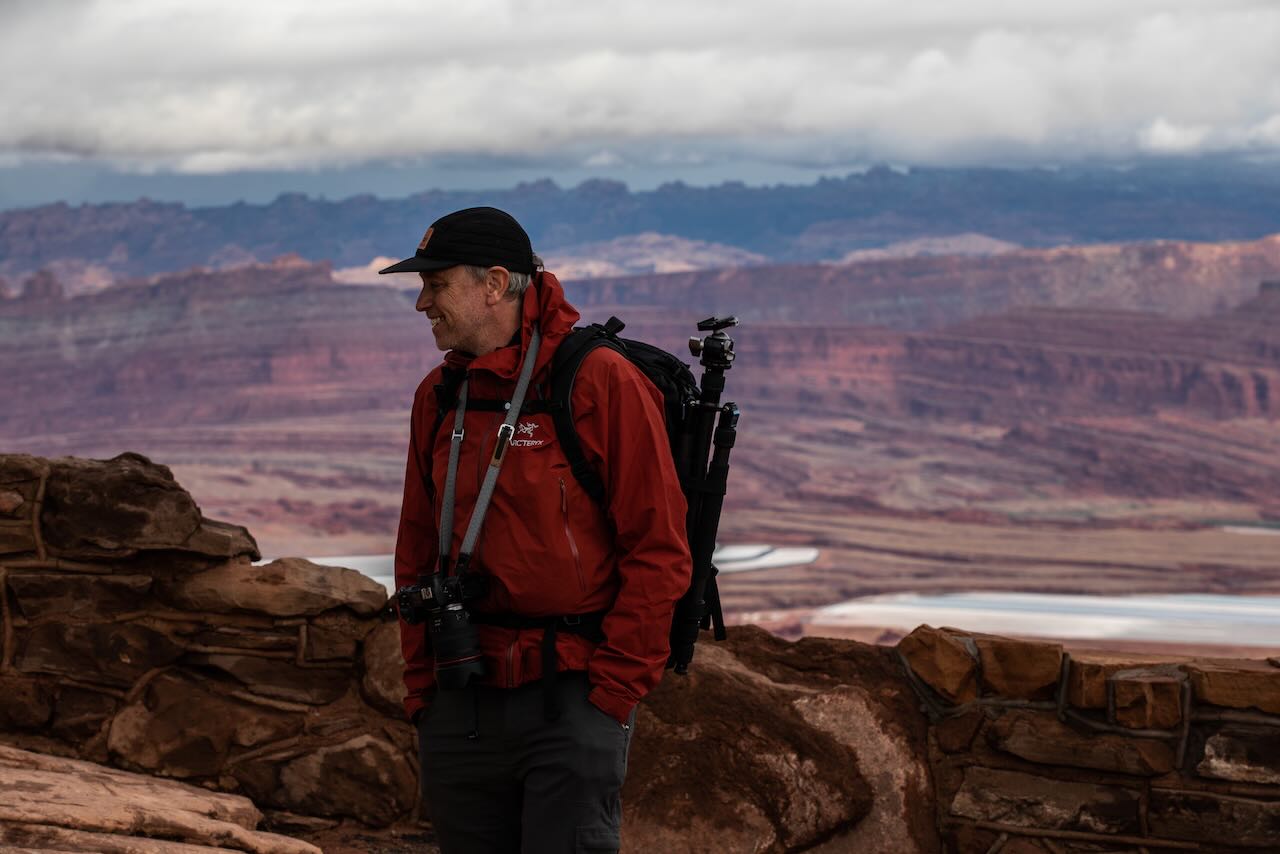
Kurt Windisch sets up for sunset at Dead Horse Point State Park, which overlooks the Colorado River and the Potash evaporation ponds. The park got its name because cowboys once fenced its narrow neck to corral horses, which were then left to starve. Photo by Winston Ross
Whom you travel with makes all the difference. A few months before the pandemic paralyzed the world, I took my last overseas trip, to Ireland with a group of fellow writers and public relations types, to soak our livers in whiskey and fill our gullets with rich food. After four days, I felt like foie gras, swore to avoid invitations like it in the future and to focus instead on exploring the American West with a kayak on the roof and a mountain bike hitched to a rack, in search of my own personal trifecta: (1) clean, swift whitewater that parallels (2) smooth, flowy singletrack connecting (3) one quiet, dispersed riverside campsite after another.
I’d make a mission, I resolved, of finding every place west of the Rockies where I could start the day hauling an inflatable kayak to a river put-in, get it all set up and then drive down to the take-out, park the car, hop on my bike and scramble back to the put-in, lock the bike securely to something and then spend the rest of the afternoon floating to my waiting vehicle. That’s what a perfect day looks like, and even as the pandemic cloistered people around the world in their homes and urbanities, I roamed, never catching a case.
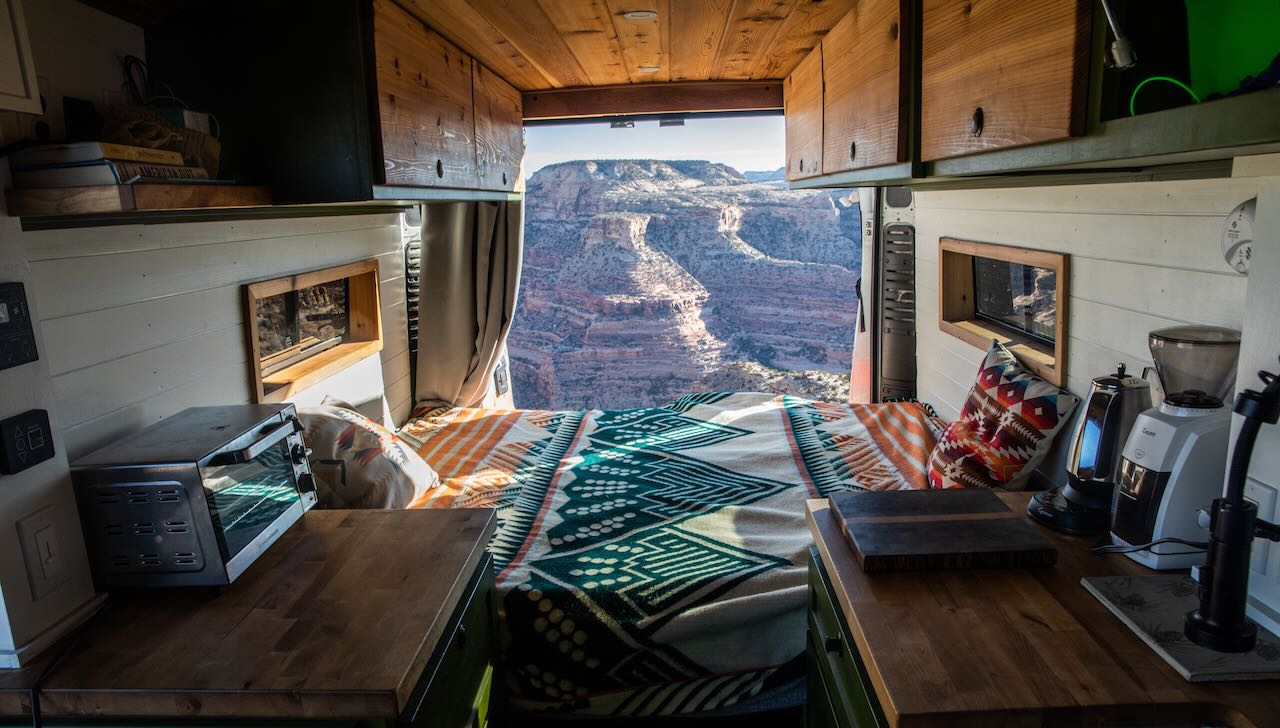
Our first dispersed campsite, at The Wedge Overlook, on the northern end of the San Rafael Swell in Utah. Not a bad view from the van. Photo by Winston Ross
By the fall of 2022, I’d emerged from the thick of the pandemic with proceeds from renting my home out on Airbnb funneled into building the camper van, and proceeds from that venture affording this two-week venture east, where rivers to run might be too cold or too low for my tastes but where some of the finest flowy singletrack sluices through forests and across mesas and down the faces of towering peaks: to the Western Front of Colorado and the red rocks of Utah. I didn’t know much about the expertly designed networks tucked into these places, but Kurt did. So when he suggested this journey to the high desert, I was in, and knew I’d have the most capable guide around.
After a night in Kurt’s driveway and some dialing in of the van, my border collie Alsea and I took off for Idaho at an hour past dawn, a few hours ahead of Kurt in his own Dodge Sprinter and his own sheep dog, a mostly Australian Shepherd named Indy, after Indiana Jones (or, the family dog), of course. I was hoping to make it as far as Idaho Falls to shorten the next day’s drive, and thanks to iOverlander I found a magical spot on the Snake River to camp for the night, where Alsea could drench herself in a twilight swim and emerge filthy and calm, while I battled a swarm of warmth-seeking flies and heated up some homemade spanakopita in a toaster oven. Kurt nearly caught up to me despite the later start, he reported, and pulled into a rest area to sleep.
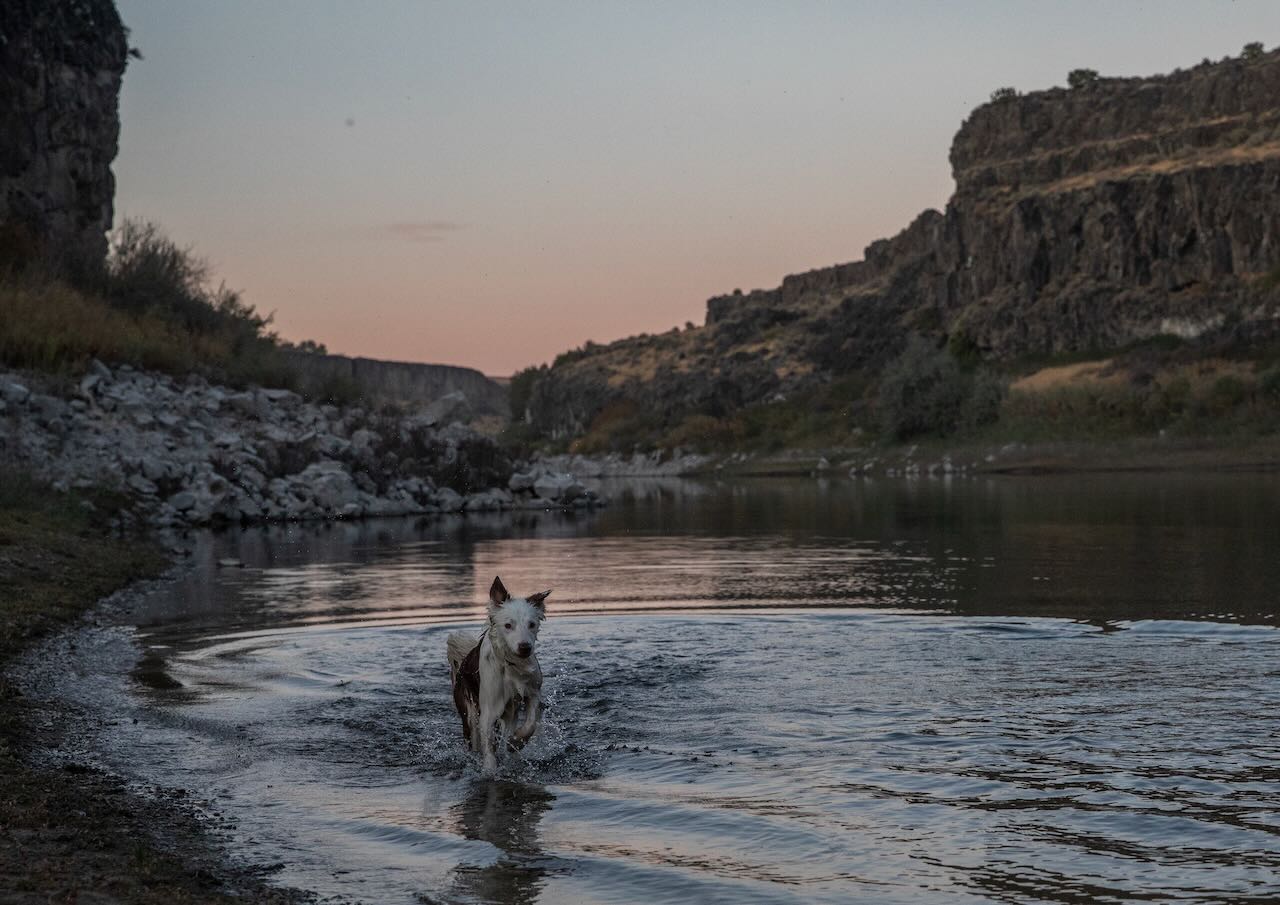
Alsea takes a dip at Caldron Linn, on Idaho’s Snake River. Photo by Winston Ross
In the morning, I revved up the van and lurched it around a gnarly, rutted corner to climb out of the canyon, hoping the gooseneck tea kettle, coffee grinder and fancy Ratio coffeemaker I’d perched stupidly on the van’s butcher block countertops would hold their positions. Somehow they did, and I barreled towards Utah en route to another canyon, this one a thousand times more splendrous, a place I didn’t even know existed before a dusty road led right to its rim.
The Wedge Overlook is a marvel that takes its visitors to the San Rafael River’s Little Grand Canyon. It’s one of those places that ignites the travel writer’s dilemma: by including in a piece, am I going to ruin the place, cause it to be discovered and then bombarded with would-be Instafluencers from the four corners of the earth? I hope that the travel time it takes to get there from the nearest major airport will prevent such a swarm, because Kurt and I were grateful to crawl our vans to the edge of the canyon and find a spot to park them both, set up a couple of camp chairs and gawk at one of the most spectacular views I’ve ever seen. As the sun plunged into the horizon, unfettered stars popped up, one by one, then the milky way stretched itself out like a blanket into the night sky.

Campers set up under the stars of the Milky Way on the rim of the San Rafael river canyon at the Wedge Overlook. Photo by Kurt Windisch
I’d have been satisfied just to sit at camp the next day, but a perfect hiking and mountain biking trail lay too close to ignore, wending its way right at the edge of the canyon, tracing each finger as if a child were outlining her hand on a piece of paper. Alsea galloped happily between Kurt and my bikes, racing back and forth between us to keep the herd together. Indy stood vigil at camp (he’s still a bit rambunctious for a long trail ride.) We stopped to water and rest the pup and for photographs, which were an impossible medium to capture the grandeur of The Wedge. Halfway out, we flipped our bikes around and rode back, in enough time to whip up tacos ahead of another magic sunset, and another night beneath the galaxy before the next day’s drive onward.
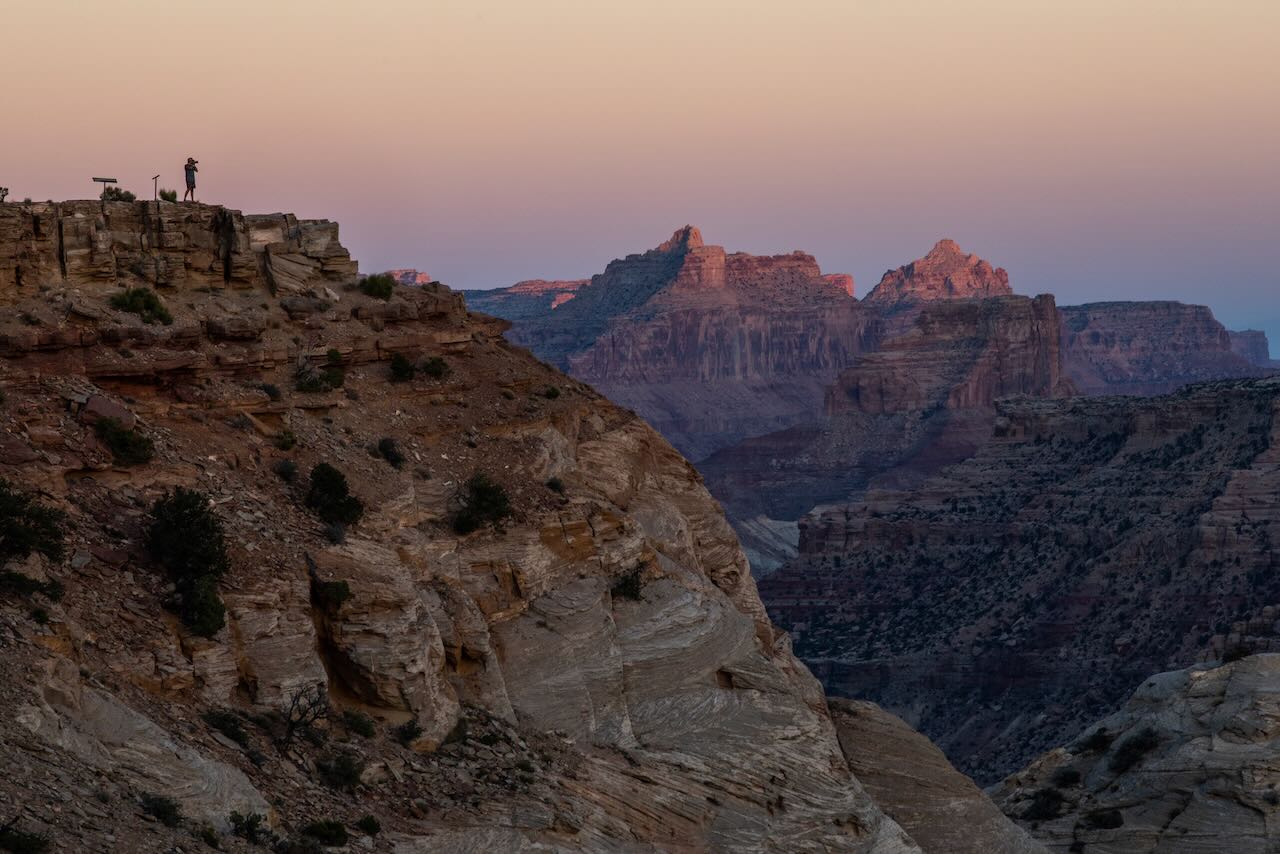
Overlooking the Little Grand Canyon and peeking into Buckhorn Draw, our route south towards Fruita. Photo by Winston Ross
From The Wedge we barreled towards one more mountain biking mecca in Colorado’s Grand Valley. Kurt split off for a beautiful campsite at the base of Pike Ridge, I drove a bit sheepishly to a welcome shower at the Wine Country Inn, an oasis tucked into rows of vineyards in nearby Palisade. The van is a luxurious way to camp, but my freezer had stopped freezing and I had strawberries melting in it, plus a king-sized bed, a hot tub and a breakfast made by someone else already sounded nice. There’d be plenty of roughing it to come.
When I met him at camp the next morning for our first ride of Fruita’s 18 Road network, Kurt was irritated at Indy for spending every waking moment outside foraging and at the flies that seem to be following us from place to place. But before long we were dirtside, ripping up and down the Book Cliffs in a series of loops each offering their own unique scenery and terrain; some rocky, some smooth; some riding right along the spine of a narrow ridgeline, some rollercoastering into canyons below.
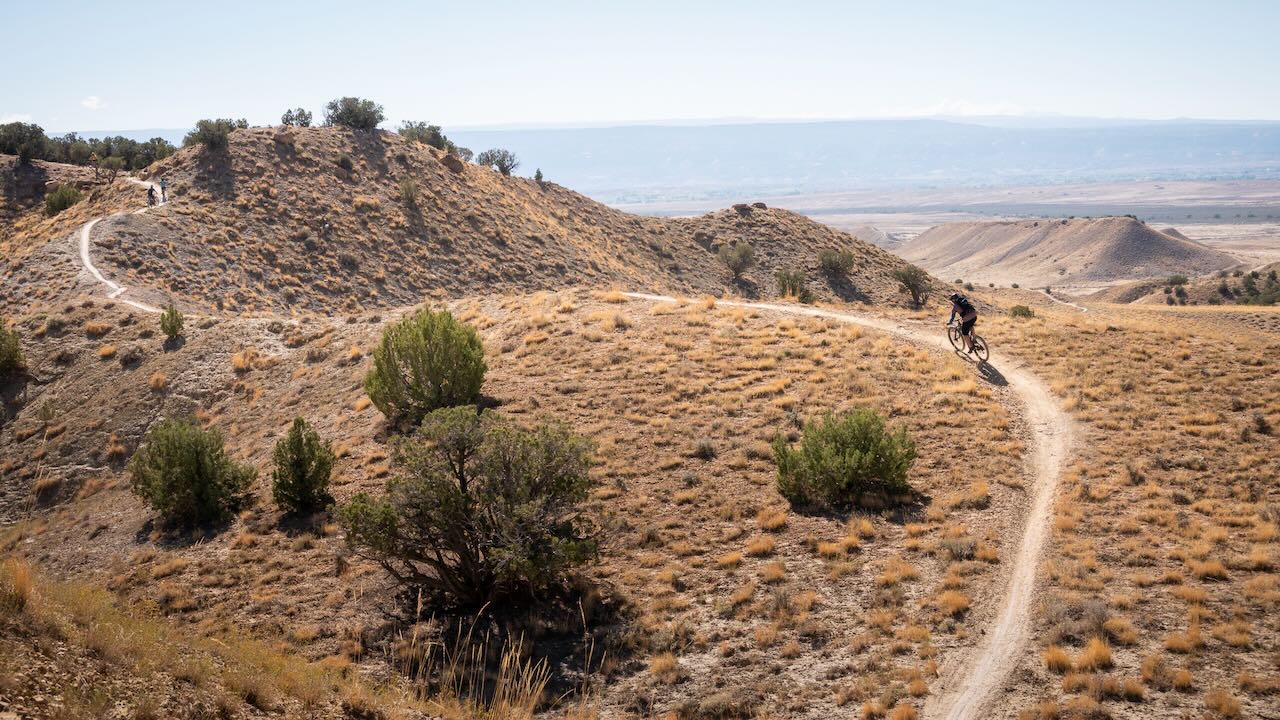
Descending Joe’s Ridge trail at 18 Road trails area of the North Fruita Desert. (One of the first BLM sites that I’m aware of to legalize class 1 ebikes!) Photo by Kurt Windisch
“Get your seat out of your ass!” Kurt yelled, issuing what had become a frequent admonition for me to drop my seat post on the descent so I’m not lurched over the handlebars, and to carve through turns by whipping my bike side to side instead of steering from the front. We have much in common, but very different styles, each more entrenched the older we get. Kurt is a left-brained software engineer who has held down steady jobs for 25 years, in a happy marriage for most of that. I haven’t had a full-time gig since 2016 and what passed for a marriage for me lasted all of six months. Our friendship is based more on a shared love of photography and the outdoors, specifically mountain biking in it, and he has for much of the past two decades been a patient teacher, a maven and a generous host, at his home in Bend, Ore. I know he’s riding the “right” way, but it doesn’t click for me. The seat being wedged between my thighs feels like stability, or something. And it’s how I’ve been riding for 20 years.
After an off day scrubbing the van clean at the Inn, we had to decide whether to explore one of the valley’s half-dozen other trail networks or return to Fruita for the tracks we’d skipped. We chose the latter, Kurt joining for the first loop or two and then skipping out for our next destination while I stuck around to see if I could put wheels to every inch of trail available. Alsea was wiped from the morning runs, so I left her vigil at the van and burned through another 10 miles of blissful track.
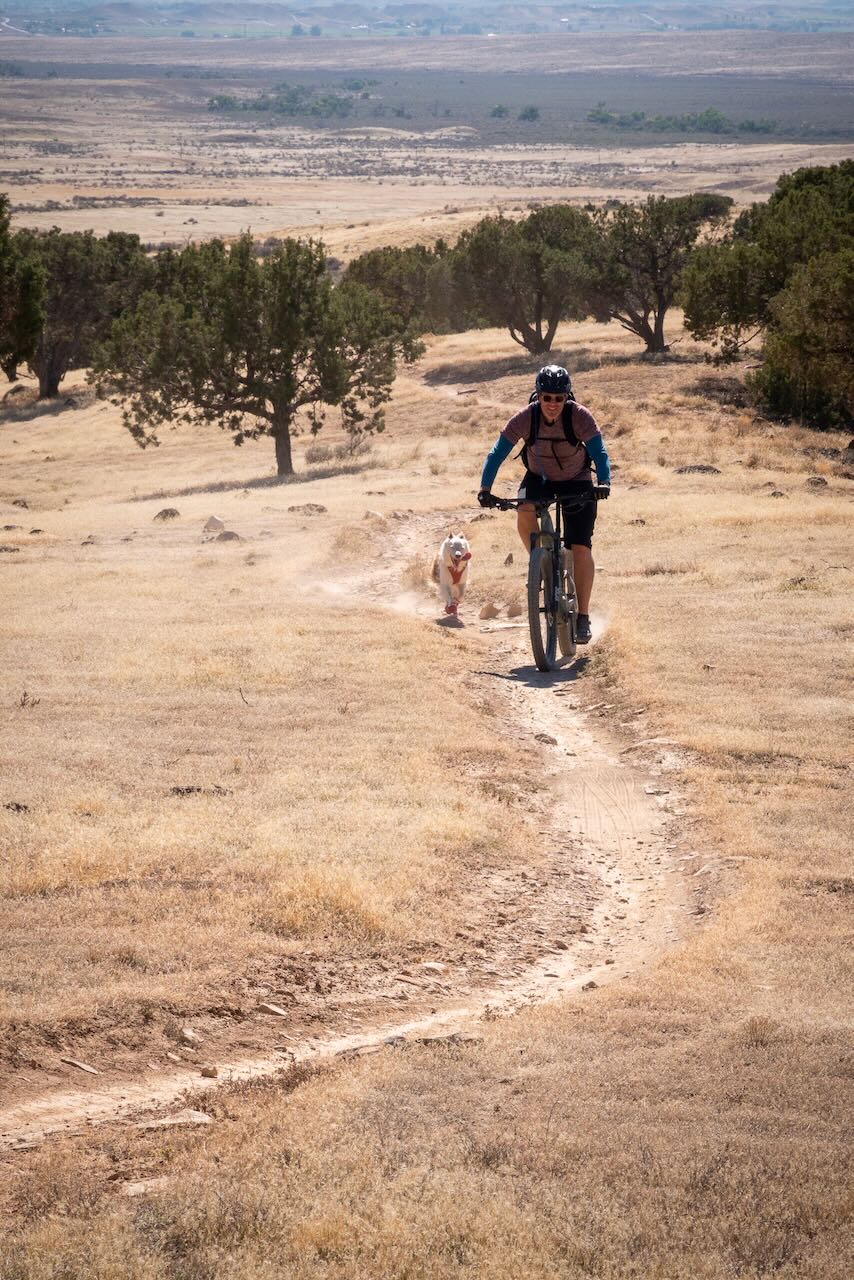
Climbing through the North Fruita Desert on “Western Zippity”. Photo by Kurt Windisch
The next day I checked out of the Inn and headed to Cortez, where Kurt and I had made reservations at an RV park. But after Kurt beat me there and offered a tepid endorsement of the place (“It’s an RV Park”) I took a detour to another magical spot I’d never heard of: Orvis Hot Springs, in Ridgway.
Hot springs, which abound across the west and range on a spectrum from completely wild and natural (and sometimes unkempt) to manicured and spa-like, effectively the pumping of mineral water into a pool or hot tub-style enclosure. Clothing-optional Orvis blends these two aesthetics beautifully, with a series of pools scattered across thoughtfully landscaped grounds as you might find a series of chain lakes on a backpacking trip. There’s a 110-degree “lobster pot” just across from a refreshing cold plunge tub, right next to a sizzling sauna. There are big pools with foot massaging gravel crunching beneath one’s feet, and there are private pools indoors, next to a fully functioning kitchen, excellent coffee and a filtered water fountain. I parked the van at Orvis, in a simple spot with a small wooden platform next to the van and a panoramic view of the surrounding San Juan mountains, into which I’d emerge after one blissful soak again the next morning.

Fall colors pop in Colorado on the drive from Ridgway to Cortez.
The drive from Ridgway to Cortez is just stunning, along two-line highways carving through valleys bursting with glowing yellow aspen trees around every turn, forests fading upwards to rocky mountaintops towering overhead. It was hard not to stop for photographs every thirty seconds, even as another epic ride lay tantalizingly ahead.
Phil’s World might sound like a theme park for middle-aged cubicle dwellers, but it is with no hyperbole a true world of roller-coaster singletrack, with short bursts of mildly technical climbs immediately rewarded with swooping, left-to-ride blasts back down again. I strapped Alsea’s new Ruffwear booties on as tight as I could get them (at $48 a pair, it sucks to lose one) and blasted off into the mesa, figuring if I just took every left turn I saw I’d take the widest loop available and wind up back at the car happily exhausted.
That was a dumb strategy, in hindsight. Left turn after left turn shot me way off of the main map and about as far from the trailhead as possible. Once Alsea began to lag more than I’d expect her to even after two hours on the trail, I called Kurt to pick us up at a different trailhead and discover upon removing her boots caked blood from raspberries that had apparently formed from the boots rubbing against her dew claws. I bandaged her up and loaded her into Kurt’s van, knowing Alsea had run her last ride for this trip. We headed to the RV park, where I could catch up on laundry and my weary dog could rest. Moab, the beacon of our journey, was a three-hour drive.

Alsea scales red rocks at Dead Horse Point State Park. Photo by Kurt Windisch
I didn’t have any lodging reserved the following day, so I hightailed it for red rock country as soon as my coffee was finished brewing, straight to what Kurt imagined might be a lesser crowded campground and a good jumping off point for the kinds of trails I liked: Horsethief Campground, which lies on a plateau above the Paradox Basin about 20 miles from Moab proper, past Arches National Park, en route to Canyonlands.
He was right, per usual. I had my pick of a dozen different sites, and I backed into one with a lovely view of the undulating maroon sands stretching out towards the horizon. For the rest of the afternoon, Alsea and I hunkered down in the van, grateful for its steel frame, as blustery winds pulled in an apocalyptic storm front from the north. Windy weather is about the only thing that stops me from “doing something,” especially on a road trip, so I was a little grateful to be stuck inside. That night, lightning strikes from a dozen miles away warned of an impressive rain and hailstorm pelting the roof of the van, and what started as sporadic sleet morphed into a full-fledged deluge the following morning. There would be no mountain biking the next day, or maybe the day after that. Mother Nature had gone on strike.
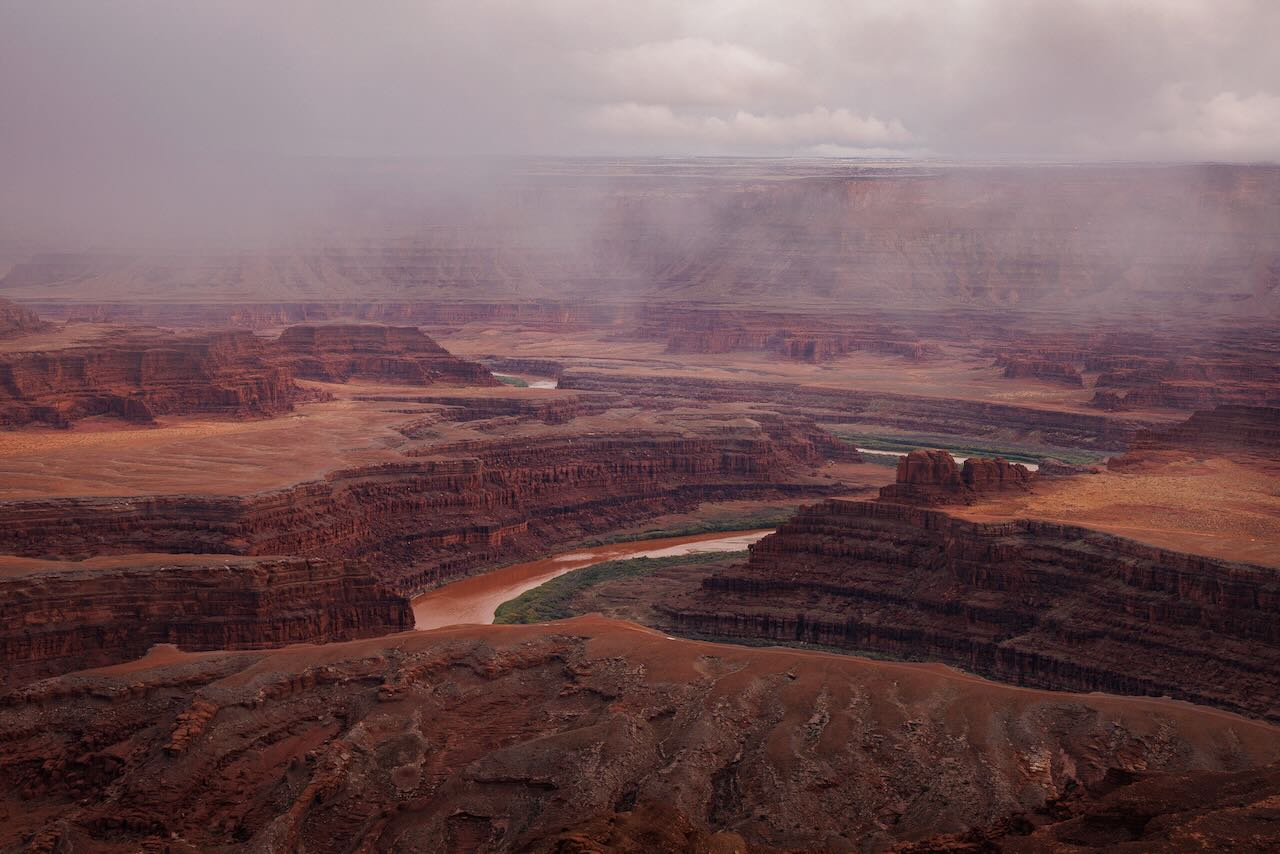
Colorado River winding through the canyons below Dead horse Point as a storm clears. Infamous Thelma and Louise Point sits just down the road pictured at the canyon edge. Photo by Kurt Windisch
The lazy Sunday offered a stretch of writing and photo-editing, and Kurt and I plotted a good opportunity for a walk, once the front had rolled over Moab. I checked into the second and final hotel of the trip, the idyllic and sparkling new Radcliffe Moab, pleased at my inadvertently prescient escape from the first real rain I’d seen in months. With its spacious and perfectly appointed rooms, heavenly beds and smart mashup of mid-century modern vibes with utilities like SteadyRack bike trays and a soft-sided cooler mounted to a custom wooden wall rack, I knew straightaway that this was a lodge that has travelers like me figured out: creature comforts (a Fellow electric kettle in every room!), but just the right amenities for the dirtbags among us.
We got our first solid ride the day after the deluge, my first real slickrock trail, a doozy of bunny hops and steep drops navigable via a chalked line that weaves through a Seussian series of Navajo sandstone formations, the kind for which Moab is beloved. After a couple harrowing miles, we headed back, wearier than we should have been, given the length of trail traversed. The next day, the trails at Dead Horse State Park had dried up enough for a longer loop through a blend of nicely packed red dirt and not-too-technical slabs of more slickrock. I’d hoped Alsea’s feet would be healed enough for another round of riding in her boots, but towards the end Kurt noticed blood soaking through her shoes. We were close to the trailhead, thankfully, but it would be Alsea’s last ride of the trip.
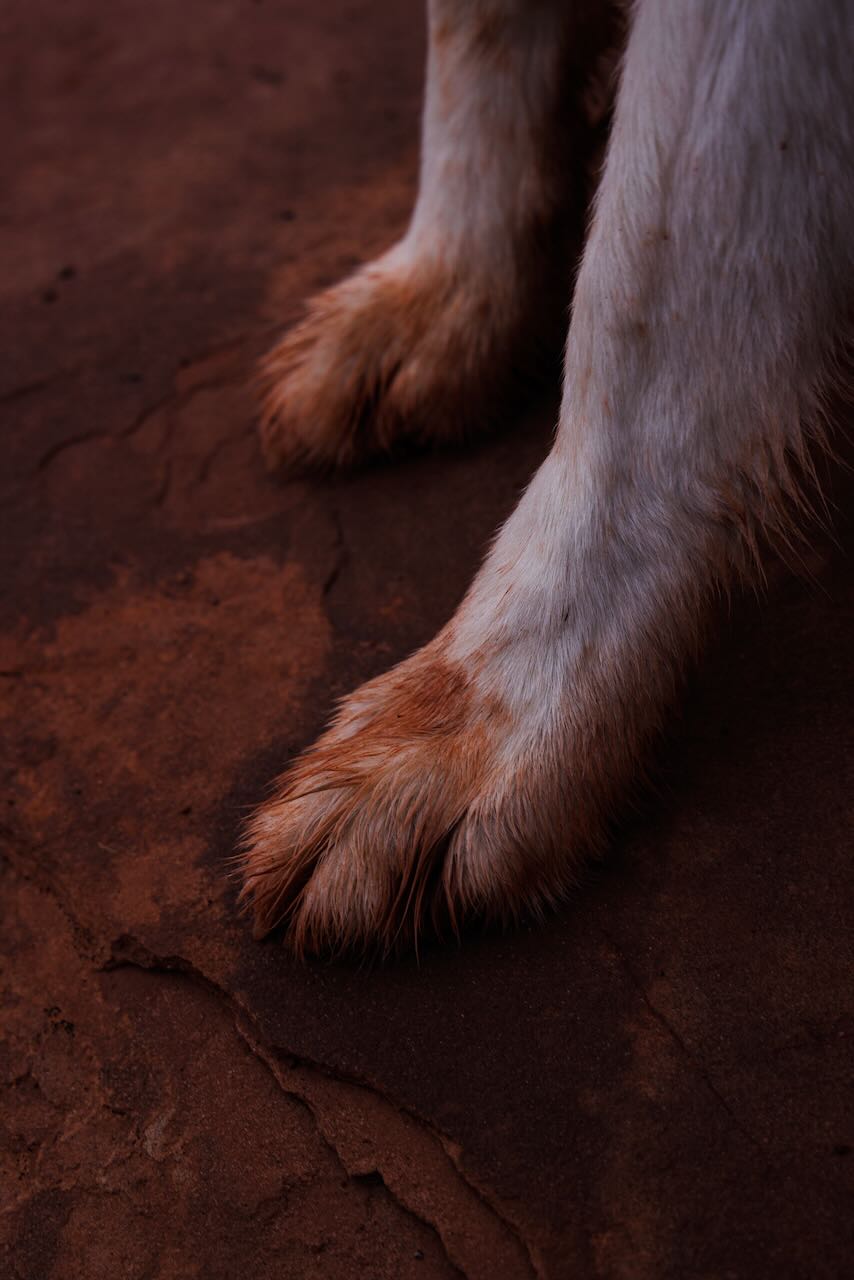
Indy’s paws reflect the red mud on Utah’s singletrack. Photo by Kurt Windisch.
Mine came a couple days later after an overnight in Boise, on the way home. I found a trailhead parking lot off of the road to the capitol city’s closest ski resort, Bogus Basin, and in the morning I scoured MTB Project for a good hearty climb and flowy descent to close out an epic road trip and likely the 2022 season. With no sherpa in Kurt to guide me, I was on my own, this time.
Photos by Winston Ross and Kurt Windisch
Our No Compromise Clause: We carefully screen all contributors to ensure they are independent and impartial. We never have and never will accept advertorial, and we do not allow advertising to influence our product or destination reviews.


